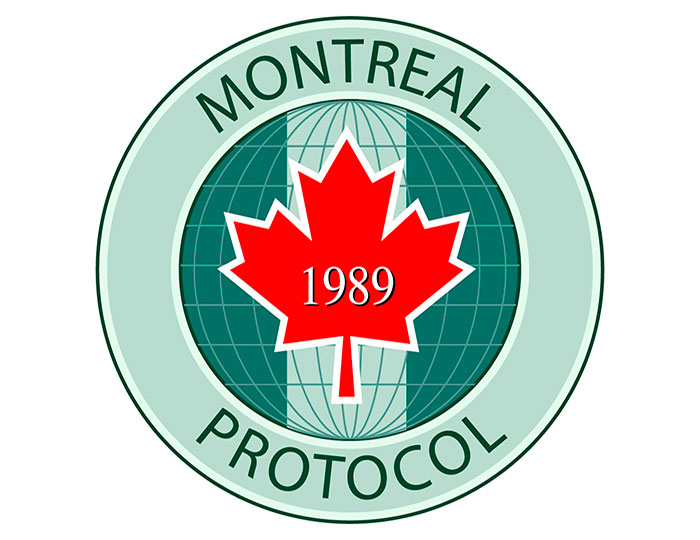Updated January 2019
The discovery of the holes in the ozone layer and how the problem was addressed by the Montreal Protocol, is a clear example of how research and scientific discoveries on climatic and environmental anomalies can be discussed and resolved successfully by nations through agreements, treaties and protocols, when there is consensus and the will to do so.
The ozone layer, or ozonosphere, is the natural filter of our planet and is essential for life on Earth. This natural protective shield of the planet absorbs up to 99% of ultraviolet (UV) rays, helps reduce the risks of skin cancer, cataracts and prevents the suppression of the human immune system.
The sizes of the ozone holes respond to seasonal phenomena. They are larger during the spring in the polar regions and smaller during the summer. In Antarctica the problem of holes is more serious than over the Arctic, due to climatic phenomena of the southern hemisphere.
The ozonosphere is located mostly in the stratosphere, although 10% is in the troposphere. It was discovered by Henri Buisson and Charles Fabry in 1913. Gordon Miller B. Dobson made the first systematic measurements of stratospheric ozone. Between 1928-1958, it installed a worldwide network of ozone monitoring stations, which continues to operate today. In his honor, the unit of measurement of ozone is named Dobson Unit.
Frank Sherwood Rowland, a US scientist, and his collaborator Mario Molina, a Mexican scientist, demonstrated that chlorofluorocarbons (CFCs) reduce the ozone layer. CFCs are gases used in refrigerators, air conditioners and atomizer thrusters. The National Academy of Sciences of the United States, in 1976 granted credibility to this hypothesis. As a result of this, Canada, Sweden, Norway and the United States took the first initiatives for the elimination of CFCs in aerosols.
Joseph Farman, Brian Gardiner and John Shanklin, of the British Antarctic service, set the alarm in 1985 by publishing in the journal Nature an article documenting how the ozone layer, located on the Antarctic continent, was reducing faster than anticipated. Due to this, the southern hemisphere of the Earth is the most affected by the problem of ozone holes, with Chile and Argentina being the two most vulnerable countries in South America.
Already at that time the world was aware of the seriousness of the problem and began to outline plans, whose urgency is deduced from the date on which the Montreal Protocol was negotiated. It was within the framework of the Vienna Convention, in 1987. They signed 43 nations.
The Montreal Protocol entered into force on January 1, 1989. On the same day, the twelve countries of the European Community banned the use of CFC, which was replaced by hydrochlorofluorocarbon (HFC), which also destroys the ozone layer, although its effect is 20 times less than that of the CFC. For this reason, its use is temporary, until finding a definitive substitute. In 2006, the CFC was banned worldwide, also to be replaced by the HFC.
In recent years, it was discovered that HFC is a dangerous greenhouse gas, with a global warming potential much greater than that of carbon dioxide. In view of this, a new amendment to the Montreal Protocol was negotiated to gradually reduce the use of HFCs worldwide. This is the Kigali amendment, signed by 197 parties in Kigali, the capital of the Republic of Rwanda, in December 2016. Entered into force on January 1, 2019.
Despite all these drawbacks, the Montreal Protocol works, and it is very important that all settled agreements are fulfilled.
To NASA we must recognize the constant monitoring of the atmosphere, and in this case of the ozone layer, crucial to know the state of the matter. The space agency says that if the Montreal Protocol had not been signed, two thirds of the ozone layer would have been destroyed. UV radiation, which damages DNA, would have increased six times. Barely five minutes of exposure to the sun would have caused skin burns.
Sandor A. Gerendas-Kiss
Fuentes
UN Environment. World takes a stand against powerful greenhouse gases with implementation pf Kigali Amedment. Retrieve from https://www.unenvironment.org/news-and-stories/press-release/world-takes-stand-against-powerful-greenhouse-gases-implementation
Wikipedia. Montreal Protocol. Retrieve from https://en.wikipedia.org/wiki/Montreal_Protocol
United Nations. International Day for the Preservation of the Ozone Layer. Retrieve from http://www.un.org/en/events/ozoneday/background.shtml







Leave A Comment